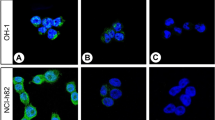Abstract
Delta-like protein (DLK) is a membrane protein with mostly unknown function. It is expressed by several embryonic tissues among others by the hepatoblasts of rodent and human fetal livers. We have investigated in the present study if this protein is expressed in human hepatoblastomas. The presence of DLK has been studied by standard immunohistochemistry in 31 hepatoblastomas and in several differential diagnostically related tumours: hepatocellular carcinomas and in undifferentiated childhood neoplasms. All the hepatoblastomas were positive for DLK; the surrounding liver tissue remained negative. The reaction was present in the epithelial component of the tumours. The staining pattern was mostly membranous, occasionally cytoplasmic. The other studied tumours were negative for DLK, except one hepatocellular carcinoma and the differentiating cells of two ganglioneuroblastomas. Therefore, DLK seems to be a highly sensitive and specific marker for hepatoblastomas.


Similar content being viewed by others
Abbreviations
- DLK:
-
delta-like protein
- AFP:
-
alpha-fetoprotein
- TLCT:
-
transitional liver cell tumour
- MPNST:
-
malignant peripheral nerve sheath tumour
References
Artavanis-Tsakonas S, Rand MD, Lake RJ (1999) Notch signalling: cell fate control and signal integration in developmentt. Science 284:770–776
Baladron V, Ruiz-Hidalgo MJ, Bonvini E, Gubina E, Notario V, Laborda J (2002) The EGF-like homeotic protein dlk affects cell growth and interacts with growth-modulating molecules in the yeast two hybrid system. Biochem Biophys Res Commun 291:193–204
Baladron V, Ruiz-Hidalgo MJ, Nueda ML, Diaz-Guerra MJ, Garcia-Ramirez JJ, Bonvini E, Gubina E, Laborda J (2005) Dlk acts as a negative regulator of NOTCH1 activation through interactions with specific EGF-like repeats. Exp Cell Res 303:343–359
Edmondson HA, Steiner PE (1954) Primary carcinoma of the liver. Cancer 7:462–503
Finegold MJ, Lopez-Terrada DH, Bowen J, Washington MK, Qualman SJ (2007) Protocol for the examination of specimens from pediatric patients with hepatoblastoma. Arch Pathol Lab Med 131:520–529
Floridon V, Jensen CH, Thorsen P, Nielsen O, Sunde L, Westergaard JG, Thomsen SG, Teisner B (2000) Does fetal antigen 1 (FA1) identify cells with regenerative, endocrine and neuroendocrine potentials? A study of FA1 in embryonic, fetal, and placental tissue and maternal circulation. Differentiation 66:49–59
Hedlund GP, Carlsson HE, Shieck E, Nilsson I, Lundblad C, Arons S, Iversen AK, Looman C Jensen HE, Hau J (2003) Fetal antigen 1 (FA1) in the adult rat adrenal gland, ovary and pituitary gland. In Vivo 17:1–4
Hsiao CC, Huang CC, Sheen JM, Tai MH, Chen CM, Huang LL, Chuang JH (2005) Differential expression of delta-like gene and protein in neuroblastoma, ganglioneuroblastoma and ganglioneuroma. Mod Pathol 18:656–662
Jensen CH, Jauho EI, Santoni-Rugiu E, Holmskov U, Teisner B, Tygstrup N, Bisgaard HC (2004) Transit-amplifying ductular (oval) cells and their hepatocytic progeny are characterized by a novel and distinctive expression of delta like protein/preadipocyte factor 1/fetal antigen 1. Am J Pathol 164:1347–1359
Jelnes P, Santoni-Rugiu E, Rasmussen M, Friis SL, Nielsen JH, Tygstrup N, Bisgaard HC (2007) Remarkable phenotypic heterogeneity displayed by oval cells in rat and mouse models of stem cell-mediated liver regeneration. Hepatology 45:1462–147
Kiss A, Schnur J, Szabó Z, Nagy P (2001) Immunohistochemical analysis of atypical ductular reaction in the human liver, with special emphasis on the presence of growth factors and their receptors. Liver 21:237–246
Laborda J, Susville EA, Hoffman T, Notario V (1993) Dlk: a putative mammalian homeotic gene differentially expressed in small cell lung carcinoma and neuroendocrine tumor cell line. J Biol Chem 268:3817–3820
Laborda J (2000) The role of the epidermal growth factor-like protein dlk in cell differentiation. Histol Histopathol 15:119–129
Lee JS, Heo J, Libbrecht L, Chi I, Kaposi-Novák P, Calvisi DF, Mikaelyan A, Roberts LR, Demetris AJ, Sun Z, Nevens F, Roskams T, Thorgeirsson SS (2006) A novel prognostic subtype of human hepatocellular carcinoma derived from hepatic progenitor cells. Nat Med 12:410–416
Luo J, Ren B, Keryanov S, Tseng GC, Rao UNM, Monga SP, Strom S, Demetris AJ, Nalesnik M, Yu YP, Ranganathan S, Michalopoulos GK (2006) Transcriptomic and genomic analysis of human hepatocellular carcinomas and hepatoblastomas. Hepatology 44:1012–1024
Prokurat A, Kluge P, Kosciesza A (2002) Transitional liver cell tumours (TLCT) in older children and adolescents: a novel group of agressive hepatic tumours expressing beta-catenin. Med Pediatr Oncol 39:510–518
Roebuck DJ, Perilongo G (2006) Hepatoblastoma: an oncological review. Pediatr Radiol 36:183–186
Roskams TA, Theise ND, Balabaud C, Bhagat G, Bhathal PS, Bioulac-Sage P (2004) Nomenclature of the finer branches of the biliary tree: canals, ductules, and ductular reactions in human livers. Hepatology 39:1739–1745
Santoni-Rugiu E, Jelnes P, Thorgeirsson SS, Bisgaard HC (2005) Progenitor cells in liver regeneration: molecular responses controlling their activation and expansion. APMIS 113:876–902
Smas CM, Sul HS (1993) Pref-1, a protein containing EGF-like repeats, inhibits adipocyte differentiation. Cell 73:725–734
Tanimizu N, Miyajima A (2004a) Notch signaling controls hepatoblast differentiation by altering the expression of liver-enriched transcription factors. J Cell Sci 117:3165–3174
Tanimizu N, Tsujimura T, Takahide K, Kodama T, Nakamura K, Miyajima A (2004) Expression of Dlk/Pref-1 defines a subpopulation in the oval cell compartment of rat liver. Gene Expression Patterns 5:209–218
Tornehave D, Jensen CH, Teisner B, Larson LI (1996) FA1 immunreactivity in endocrine tumours and during development of the human fetal pancreas, negative correlation with glucagon expression. Histochem Cell Biol 106:535–542
Van Limpt VA, Chan AJ, Van Sluis PG (2003) High delta-like 1 expression in a subset of neuroblastoma cell lines corresponds to a differentiated chromaffin cell type. Int J Cancer 105:61–69
Zimmermann A (2005) The emerging family of hepatoblastoma tumours: from ontogenesis to oncogenesis. Eur J Cancer 41:1503–1514
Acknowledgement
This study was supported by OTKA K 67697, TS 049887 and ETT 32/2006.
Conflict of interest statement
We declare that we have no conflict of interest.
Author information
Authors and Affiliations
Corresponding author
Additional information
K. D and J. H. contributed equally to this work.
Rights and permissions
About this article
Cite this article
Dezső, K., Halász, J., Bisgaard, H.C. et al. Delta-like protein (DLK) is a novel immunohistochemical marker for human hepatoblastomas. Virchows Arch 452, 443–448 (2008). https://doi.org/10.1007/s00428-007-0571-8
Received:
Revised:
Accepted:
Published:
Issue Date:
DOI: https://doi.org/10.1007/s00428-007-0571-8




